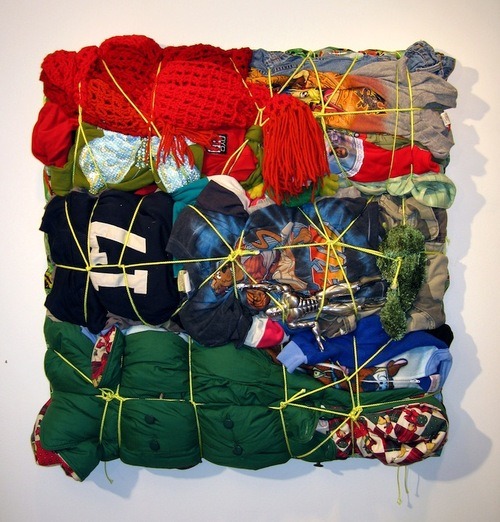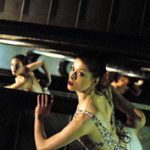Special Features: Kehinde Wiley on Shinique Smith
Mount Holly Street. Mixed media. 2005. Courtesy the artist.
New York-based painter Kehinde Wiley introduces the work of Shinique Smith.
The work of Shinique Smith navigates the leading edge of the written word. Her paper-based installations of extremely mixed visual signifiers marry literature, Islamic architecture, and hip hop music to investigate and expound the narrative capabilities of the language. In her recently-exhibited piece Dependence at the Bronx-based Longwood Art Gallery’s exhibitionConversions @ 149th St., Smith addressed the architecture of the exhibition space by adhering individual paper cut-outs of graffiti script to the walls. The script is drawn with wide-tip graf markers and a brush, then meticulously cut into shards. InDependence, paper, paint, and word crystallize to form a heaving mound of language, the content drawn from literary and musical sources: Eric B. and Rakim, the Beastie Boys, Khalil Gibran, the Bible, and James Baldwin, just to note a few. Smith’s is an engagement with the chaotic strands of memory, each competing for attention in the artist’s mind.
Smith’s tenacious obsession with the communicative capacity of the written word and its formal beauty has precedent in the Islamic calligraphic and decorative tradition of early caliphates. Koranic law forbade the depiction or representation of Allah, a rule soon extended to all forms of portraiture. In this vacuum of figurative imagery, calligraphic, floral, and decorative design elements began to acquire central importance in Islamic architectural and painting traditions. Mosques, madrassas, and even private homes were bejeweled with the most blindingly complex interweaving of Koranic quotations and decorative flourishes. A perversion of means is what made this possible, as the limit on the creative possibilities of Islamic art simultaneously begot an equal and opposite aesthetic tradition based on text and design. The self-imposed restrictions governing Smith’s textual selections are not the type of edicts from a church or state, but rather the personal kind. It’s as if she alone occupies the position of speaker, agent, and gatekeeper at once, all the while hovering just above the selective process, orchestrating the task of stylistic cohesion.

Bale Variant No. 0008. Mixed media. 2005. Courtesy the artist.
Smith’s aesthetic departs from Enlightenment-era notions of unification that still dog Western creative values. There’s no attempt to create order in her chaotic world, and this entropy of dueling styles and materials results in beauty. Her 2003 installation, Convergence, is a heap of scrawled language tumbling down a wall, comprised of paper ranging from tissue-thin to thick. The effect is delicate, but the presentation is heavy-handed to the point of brutality, especially where paper scraps are torn and discarded across the base of the wall. The black and gray text is an energetic transcription of all of the lyrics from Public Enemy’s “Rebel Without a Cause.” Though in form this work points directly to graffiti style, (Smith having been a “tagger” as a teen), it is haunted by its parallels to the work of Franz Kline, with its severe and violent slashes of black across the bleak white of the walls.
While her recent work has come to rely heavily on the three dimensional possibilities of the white cube, Smith began as a painter, and much of her current installation work operates with a deep understanding of the history of Western easel painting. The spillage of a history of signs is no easy clay to mold. But Smith has managed to carve out a territory that challenges, provokes, and explodes in a way that is truly the bomb.
Kehinde Wiley received his BFA from the San Francisco Art Institute and his MFA from Yale University, School of Art. Wiley has exhibited nationally in group shows such as Ironic/Iconic and Black Romantic at the Studio Museum in Harlem; She’s Come Undone at Artemis Greenberg Van Doren Gallery; and in solo exhibitions such as Faux/Real at Deitch Projects, NY; Pictures at Roberts & Tilton, Los Angeles; as well as Passing/Posing and, most recently, Easter Realness at Rhona Hoffman Gallery, Chicago. His solo exhibition, Infinite Mobility, will open at the Brooklyn Museum of Art on October 8, 2004.
For more information on Shinique Smith, visit her website.




